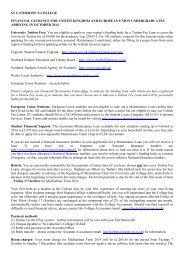Download PDF - St. Catherine's College - University of Oxford
Download PDF - St. Catherine's College - University of Oxford
Download PDF - St. Catherine's College - University of Oxford
You also want an ePaper? Increase the reach of your titles
YUMPU automatically turns print PDFs into web optimized ePapers that Google loves.
CATZ RESEARCH<br />
Sudhir Anand Fellow in Economics<br />
& Pr<strong>of</strong>essor <strong>of</strong> Economics on the publication<br />
<strong>of</strong> his new book, The Cost <strong>of</strong> Inaction<br />
© The World Bank<br />
The cost <strong>of</strong> not undertaking an action can be<br />
much greater than the cost <strong>of</strong> undertaking<br />
it. Inaction can lead to serious negative<br />
consequences – for individuals, for society, and<br />
for the economy. The consequences <strong>of</strong> a failure<br />
to address extreme poverty, for example, include<br />
child malnutrition, lack <strong>of</strong> basic education,<br />
preventable morbidity, premature mortality, and<br />
other costs borne by the poor. Failure to provide<br />
primary schooling to children can lead to lower<br />
future incomes, higher HIV/AIDS risk behaviors,<br />
increased fertility, and numerous other costs.<br />
To illustrate the application <strong>of</strong> the cost <strong>of</strong><br />
inaction (hereafter COI) approach, we have<br />
conducted six case studies – three in Rwanda<br />
and three in Angola. These studies highlight<br />
the importance <strong>of</strong> identifying appropriate<br />
interventions as sets <strong>of</strong> complementary actions,<br />
not simply as isolated single actions. An<br />
excellent example <strong>of</strong> an integrated intervention<br />
is the scaled-up FXB-Village Program in<br />
Rwanda, which consists <strong>of</strong> a set <strong>of</strong> tightly-knit<br />
complementary actions designed to lift people<br />
out <strong>of</strong> extreme poverty by enhancing their basic<br />
capabilities. The other two actions in Rwanda<br />
involve school feeding and secondary schooling,<br />
respectively. In Angola, the interventions are:<br />
provision <strong>of</strong> a community healthcare system,<br />
strengthening <strong>of</strong> the education system, and an<br />
adult and infant male circumcision program.<br />
The COI approach distinguishes between<br />
constitutive and consequential benefits. The<br />
distinction is important because in addition to<br />
the direct benefits which ‘constitute’ an action,<br />
the consequential or indirect benefits <strong>of</strong> an<br />
action should form part <strong>of</strong> the information set<br />
to evaluate its benefits. Without an explicit<br />
recognition <strong>of</strong> consequential benefits, they<br />
may tend to get ignored. For example, reducing<br />
maternal mortality will have both constitutive<br />
and consequential benefits. The constitutive<br />
benefit <strong>of</strong> an intervention to reduce maternal<br />
mortality is fewer maternal deaths. But there<br />
are also consequential benefits <strong>of</strong> mothers’<br />
survival for their children’s early development,<br />
health and education.<br />
The inclusion <strong>of</strong> consequential benefits<br />
highlights the fact that actions in one area<br />
can lead to benefits in other areas. The COI<br />
approach forces the evaluator to consider the<br />
value <strong>of</strong> an action across different sectors.<br />
For instance, the evaluation <strong>of</strong> an education<br />
intervention should take account <strong>of</strong> its<br />
consequential health benefits.<br />
In COI analysis a plural approach is taken<br />
to identify and value benefits. As in the<br />
accounting <strong>of</strong> human development, COI<br />
benefits are considered in three main<br />
dimensions: health, education, and income. The<br />
different types <strong>of</strong> benefit are listed separately,<br />
and we can think <strong>of</strong> them as a vector <strong>of</strong><br />
benefits. The vector includes both constitutive<br />
and consequential benefits, and quantified and<br />
non-quantified benefits, with the quantified<br />
benefits specified in monetary or non-monetary<br />
terms. No attempt is made at reducing values<br />
in different spaces to a common money metric.<br />
By listing benefits in different dimensions<br />
separately, the COI approach provides<br />
information that supports discussion on the<br />
evaluation <strong>of</strong> different outcomes.<br />
Interventions directed at children lend<br />
themselves particularly to COI analysis<br />
50/SUDHIR ANAND
















